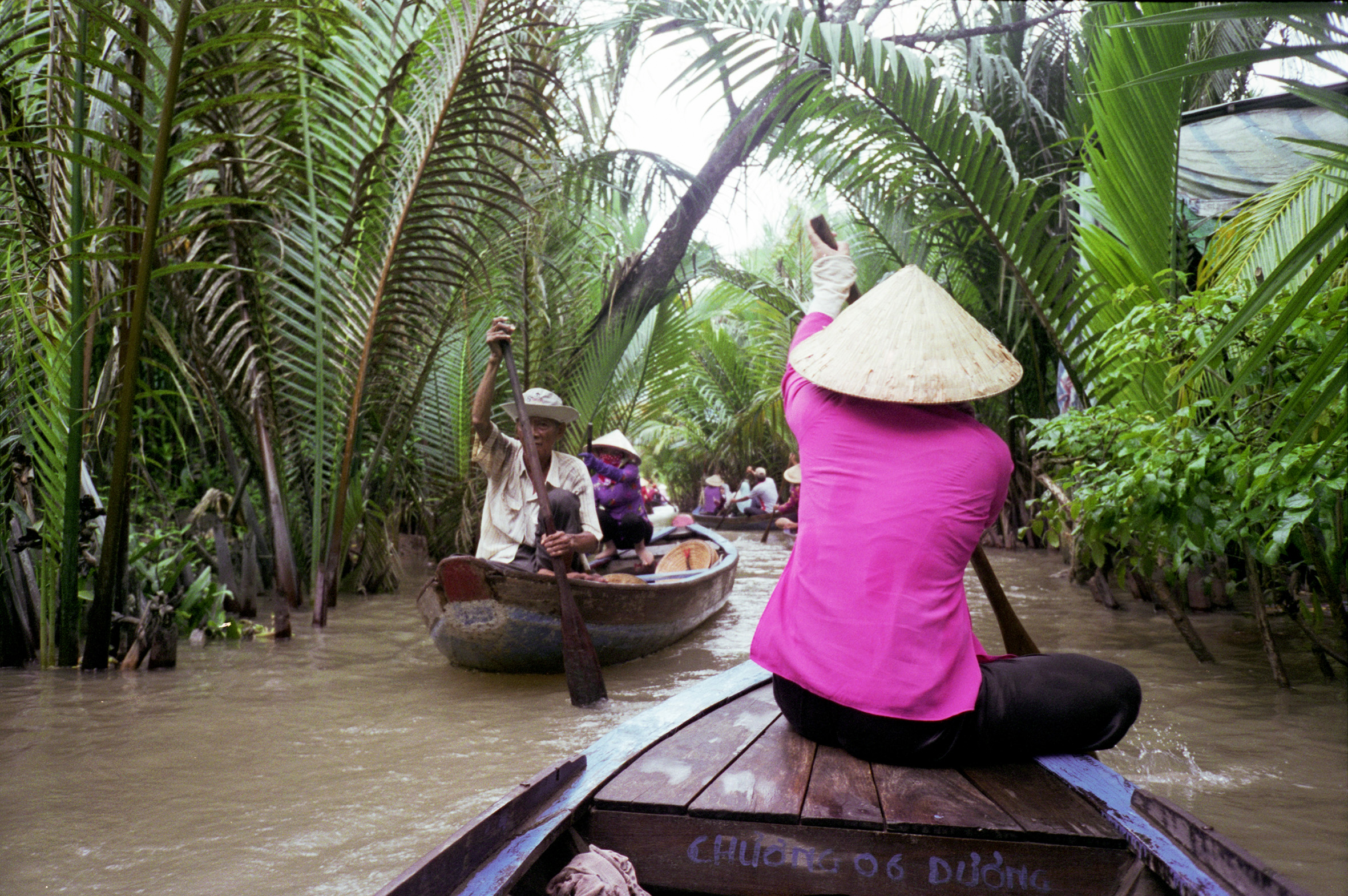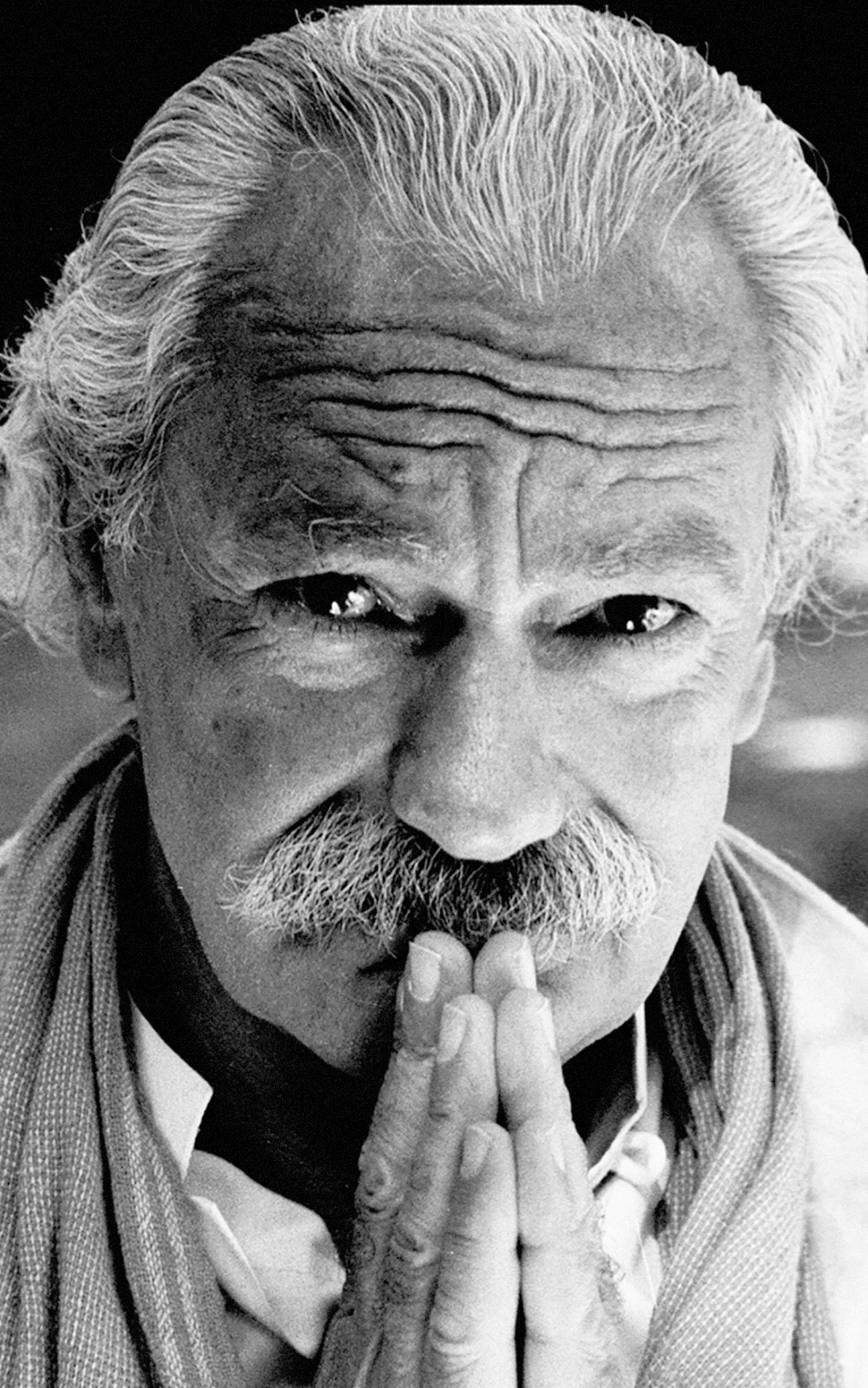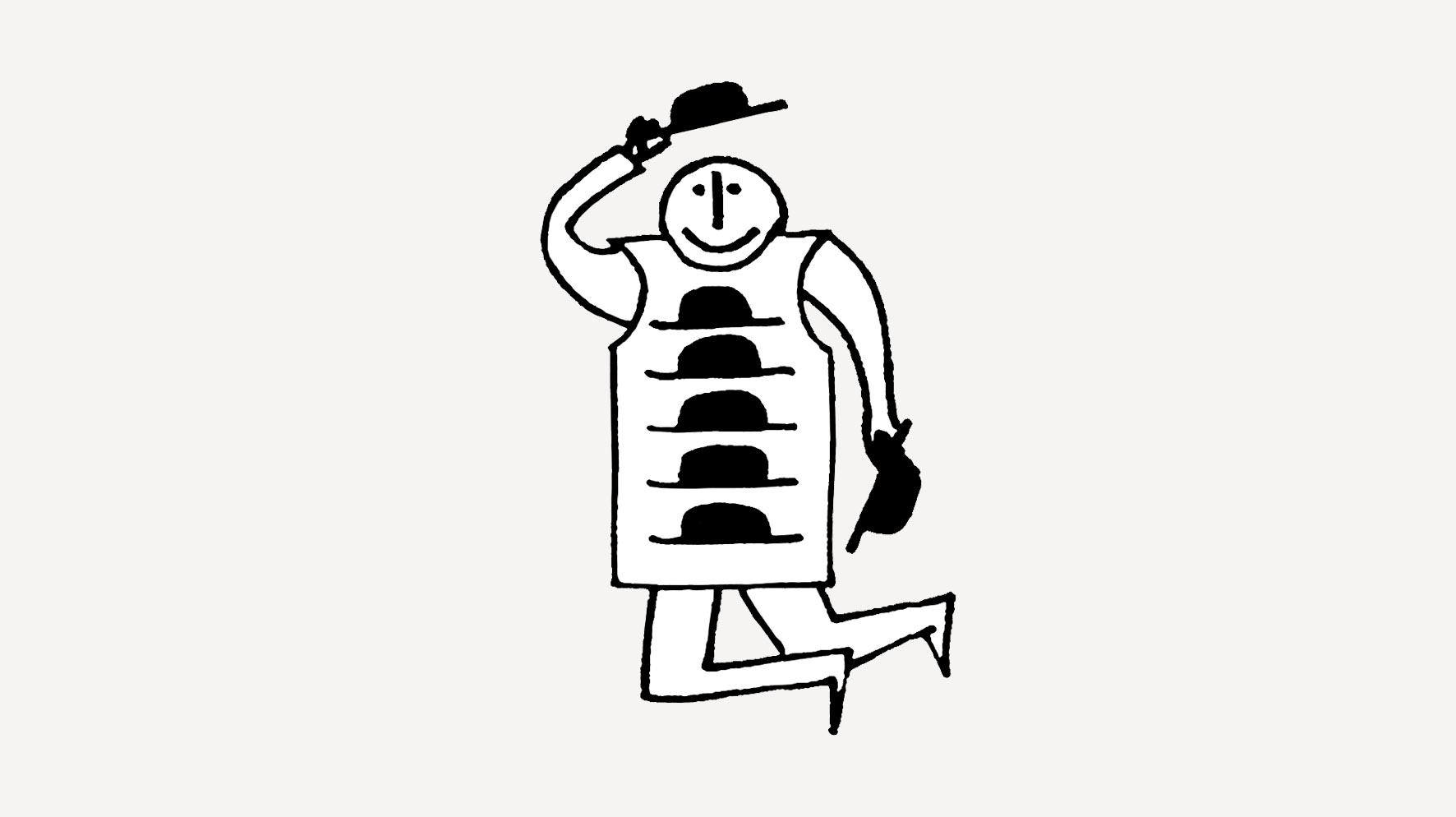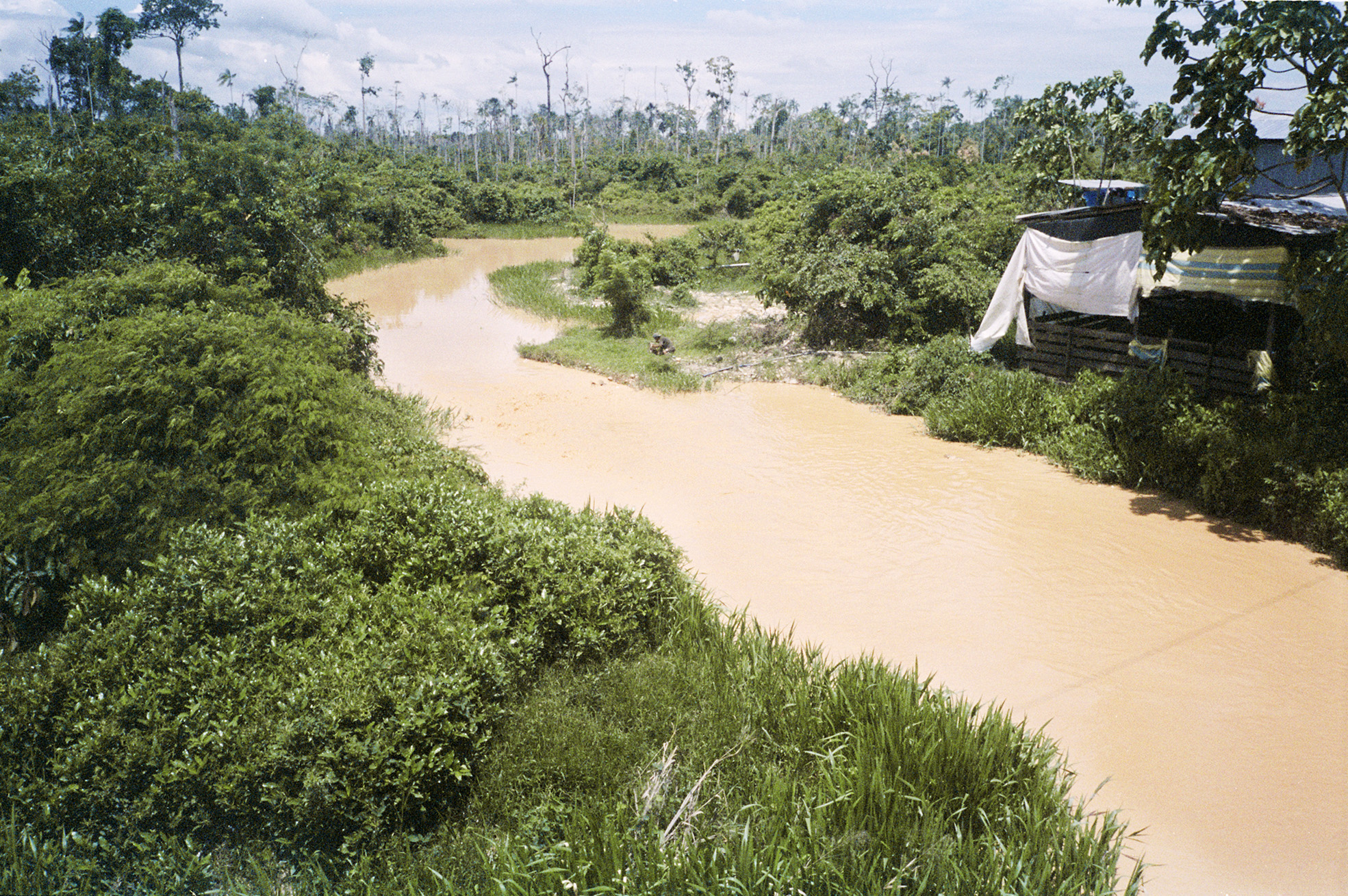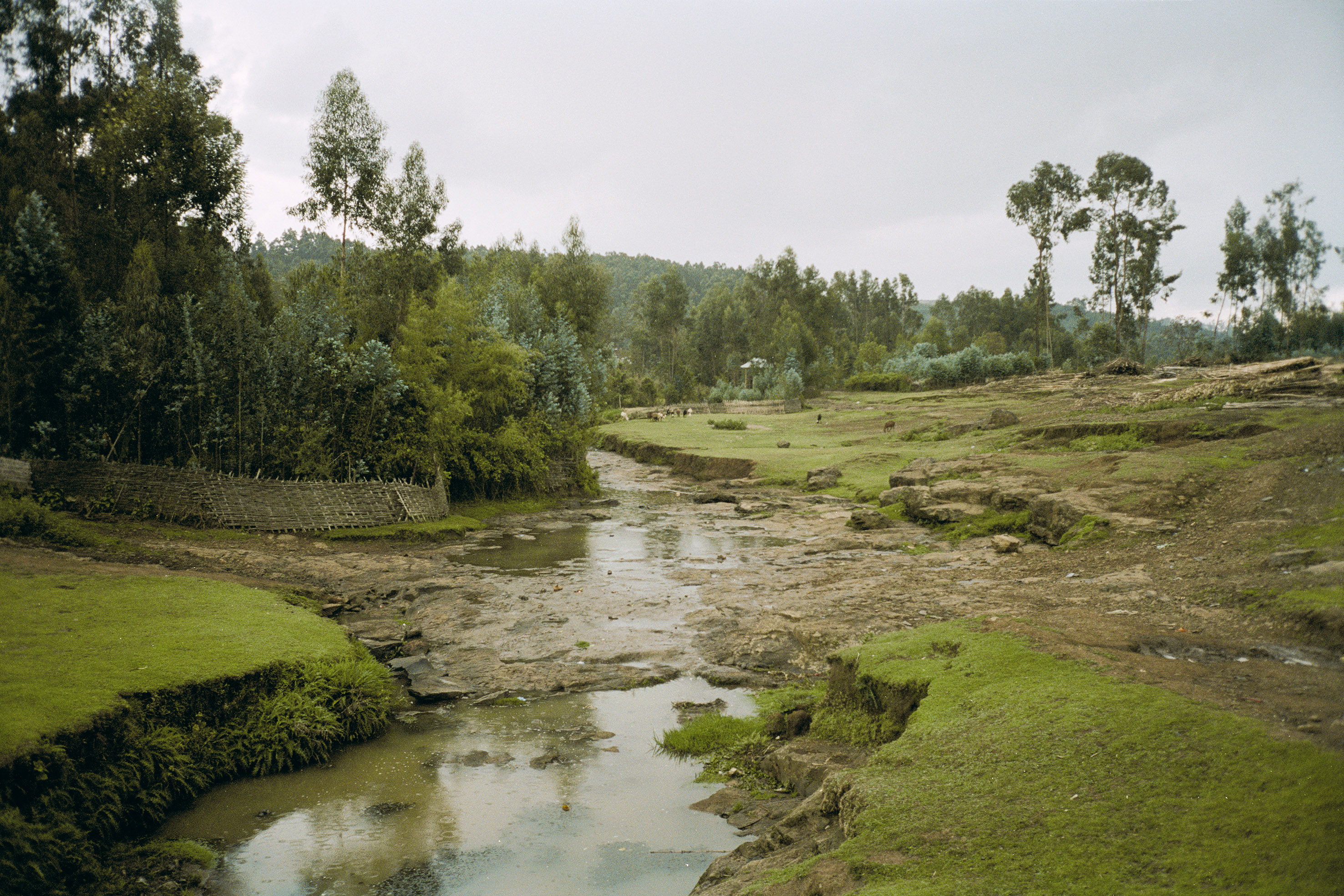
This is a story of a river that has lost its ending. Humans have robbed it of its power. This is the story of the Mekong River and its people, who have to push back from the very edge of survival, day by day.
Wet hands push the last crate, filled with fish and crushed ice. The container slides down a narrow shelf that connects the fishing boat with the shore. Someone washes it with a hose, someone else catches the box and puts it away, in a pile of other identical crates. Someone attaches a metal hook to it and drags it aside, to the women. The women sit on tiny stools. They take incoming portions of fish in their stride, not once breaking away from their conversations. One of them gets up and upends the crates. Several hands in rubber gloves reach, grabbing fish, turning them around, segregating, throwing into assigned baskets. There is certainty in every move they make. Speed without any rush. Precision without automation. The fish are examined, cleaned, sent on their way after expert consideration.
Some will be filleted; women sitting nearby are splitting their bulky silver bodies with small hooked knives. Just a few movements are enough to disembowel, cut out the gills, throw away the head. The heads smell the worst; they will be milled and canned. Larger fish go into cargo trucks, their flesh protected with ice, brought here in metre-long blocks. You need to get it on hooks, then hammer it into pieces or push it into the gaping mouth of the noisy ice crusher. On the other side of the machine, bowls filled with icy shards ride by. Workers take the fish, nestled in the cold fluff, and carry it in crates into the truck. Before breakfast, the cargo will already reach the markets of Saigon. Then, the fish will travel from the largest markets to the smaller ones in various districts. The next stop will be bowls of steaming food at homes, restaurants and street food carts.
Naked torsos, glistening shoulders. Hefting and pushing. Some fish will go to the market just by the shelter nearby. Here, you can buy in bulk and then sell it around the districts of Mỹ Tho, the first large city by the Mekong River Delta.
Everyone at the riverbank knows their roles, everyone is busy. It’s like a contract agreed a long time ago and kept in place ever since; now, mere minutes after dawn, the workers operate in perfect harmony, their moves and gestures merging in one great symphony of duties.
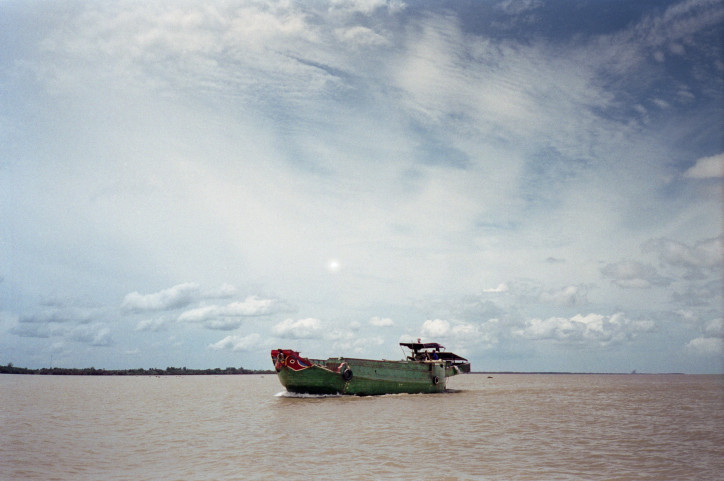
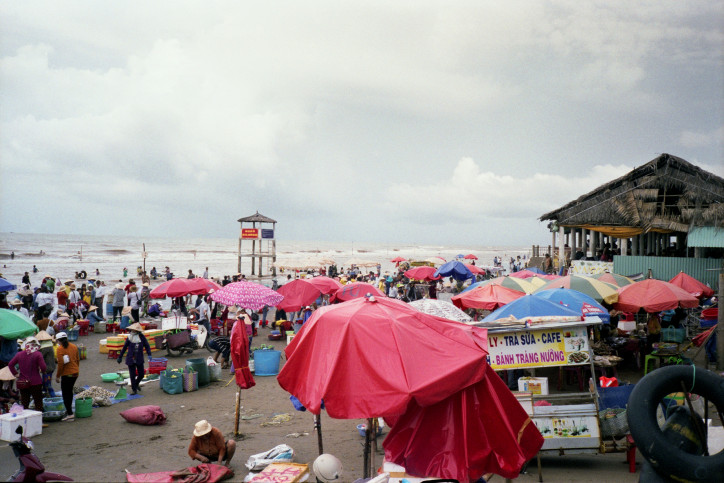
The fishermen gather on the boat. A few have emerged through the hatch of the cargo hold, now emptied. Rubber boots, sweaty T-shirts, dirty trousers, pushed into the shoe legs. The men are rushing to the pot. It stands among them now, steaming and large. Bowls and chopsticks go from hand to hand, a ladle dances above the hot surface. Before, they chattered and laughed, shouting merrily to one another. Now, there is none of that. They all crouch and slurp, sucking in the noodles, vegetables and meaty stock; they gnaw at beef bones. Leftovers fly over the board and into the water. Before they arrived at Mỹ Tho, they had spent almost a whole month at sea. The one they call the Eastern Sea in Vietnam, but the Chinese consider their own internal water basin, labelled the South China Sea in atlases. The men have been fishing for over three weeks, and now, for one week, they will rest by the river. They have a reason to be happy; the cargo hold was filled to the brim. And they were not the only ones. Round-bellied fishing boats, all painted blue, have been arriving at the riverbank since three in the morning, all of them heavy with the catch. Tomorrow will be peak traffic – it will be a full moon. Everyone will have a drink and celebrate a bit. Local fishermen live by the moon calendar, using it to measure the rhythm of their fishing trips, too. A few days before the full moon, their nets are bursting at the seams with fish. It’s rather unusual; in general, it’s only getting worse. They have to go further and further out, leaving their own waters and into the most disputed sea in the world, or to the Gulf of Thailand. There aren’t enough fish left, and there will be fewer. Over 90 million people are living in Vietnam right now, and the economy is growing quickly. The demand is increasing, both locally and outside the country. As a result, excessive fishing has already led to the decimation of the population of fish and seafood in the region.
The Delta is still bustling with life and noise, but not for long. It’s just a matter of time. Time will flow, and it will change everything.
Blocked currents
Boats and barges leave Mỹ Tho harbour. They go upstream towards Cambodia and downstream towards the sea. The old lady navigating my boat has to manoeuvre this way and that, pushing the metal steering rod with her foot. The boat’s engine sputters heavily, coughing up fumes. On the other side of Mekong is Unicorn Island, where breadfruit grows in the quiet orchards. Together with bananas, papayas, green oranges, mangoes, limes, watermelons, black cherries, coconuts, dragon fruit and reeking durians. The rain season has already begun, and soon life-giving floods will start. Water will burst its banks, carrying fertile mud onto the fields. Family plantations grow in peace, only sometimes disturbed by the peregrinations of tourist groups in the afternoons. Local farmers have learned to make some extra money out of human curiosity. In Vietnam, the holiday season is on. Whole families come here from Saigon, as well as from the middle and northern parts of the country, to visit the legendary Delta, this floating cornucopia. They walk around the display village, drink honey tea with ginger, taste some fruit, and listen to the songs of girls in trailing dresses. Then they all sit in rowing boats, put on the traditional cone-shaped hats, and let the locals drive them about romantic narrow canals. The visit ends with dinner in one of the tiny family-owned restaurants over the river. The famous elephant-ear fish proves an absolute hit. During the dry season, more tourists come over, but their invasions and bulky wallets won’t save a thing.
Several hundred feet from the restaurant cluster, I walk into someone’s home garden. I am welcomed by clumps of lemongrass, grown here to chase the snakes away. I can hear mango leaves falling to the ground, and frogs swim in the canals carrying in water from the river, each waterway diligently cleaned from black mud. Soon, three mutts join me, and together we wander around the multifarious tangle of garden greenery. The owner comes out of the house, barefooted. His blue shirt is unbuttoned all the way to his bellybutton, grey trousers rolled up. He smiles at me.
All his family members are at work. Older ones at the field, younger ones in a factory. He is the only one at home, staying with his ill mother. The woman is resting in a bed made of some rough planks. She is laying on her side, her eyelids lowered, her gaze absent. At over 100 years old, her paper-thin skin is dotted with dark spots, cool hands unresponsive to my touch. She is breathing quietly, lightly, just about.
The house looks like a clearance in the woods, its shape defined by a few walls made of wooden planks. Inside, there is a kitchen with a brick hearth, a bedroom, and – the most representative – a front room. It has a table, a dirty TV set with a large kinescope, and a tall cabinet containing the most precious property in the household: framed photographs of late ancestors, incense sticks glowing next to them. The rooms are divided with plank walls, yet still it all seems like one space, permeated with sunlight slicing in through the cracks in the walls and roof tiles. It feels like being inside and outside, both at once.
The garden used to be enough to feed the family and make some money selling fruit at the market, but it’s becoming increasingly difficult to cultivate. In recent years, water is getting saltier, and there is less of it than before. Rains are weaker, droughts plague the area more often. Here in the Delta, the Mekong is called the River of Nine Dragons. The river begins high in the Himalayas, then crosses a 4000-kilometre distance from China through Laos, Thailand and Cambodia, until it reaches Vietnam, where it splays out into nine arms before flowing into the sea. Here, in its lowest part, fresh and salt waters fight and jostle. It’s a never-ending battle between river and sea currents that keep pressing into each other. How much life will remain in the Delta depends on the freshwater. If there is less rain, and sea winds push saltwater into the irrigation canals, nothing will last for long. Fruit trees will die first; palm trees and rice fields will go next. These days, each year is unpredictable; nothing wants to follow the usual order any more. Water levels in the oceans, and therefore also in the South China Sea, are rising. Climate change experts from Can Tho – which is the largest city in the Delta – say that by the middle of the current century, water levels will have risen by 50 centimetres. Canal dams will help to reduce some of the damage, but this solution will only harm the areas below the sea level, which are the most fertile and fruitful right now. They will fall prey to saltwater. The problem is enormous. By the end of the century, as much as three-quarters of Vietnam, currently a country of 90 million, will disappear underwater. It would be a little easier to deal with if the Mekong hadn’t lost so much of its precious power and water mass along the way, due to the hundreds of dams that were built on it since the 1990s. Just as in Laos, a tiny mountainous land, where a staggering 150 new dams have been built. Each of them weakens the main current of the Mekong, depriving the river of fish and life-giving sediments, full of microorganisms, where the food chain begins.
The dams are funded by China, the only nation with enough capital and resources to set up those concrete beasts that destroy the river’s natural life, taking down the communities that depend on it. From the Himalayas to Cambodia, dam-building leads to the displacement of hundreds of villages. Thousands of people who know nothing other than fieldwork and fishery are suddenly impoverished, losing their source of food and income, along with the very thing that gave their life meaning: a connection with nature, their identity and faith, the close relationship with their ancestors. The tale echoing all over the banks of the Mekong for the past three decades is a tale of banishment from native cultures, of devastated nature and – what an irony – the story of questionable economic profit. Even the Chinese analyses show that income from the energy produced by hydroelectric power plants (which is the reason for building so many dams) are lower than expected, and the plants’ potential remains largely unused. The manic thirst of the Chinese middle class for electric power is aggressively turning one of the world’s largest rivers into a hurdle track. The consequences pile up in Vietnam, where the river no longer crushes impetuously into the sea. Its ending is, quite literally, getting devoured by salt waters.
Seeing all this, young people from the Delta’s farm families prefer to work in factories instead. New plants are being set up in the new industrial estates. Foreign investors open up plenty of work opportunities, but only for those who are aged 35 or younger. The two youngest family members from the centenarian’s home now work in the fish processing plant near Mỹ Tho. Regular working hours, an unchanging salary whatever the weather, some stability. They would rather have all that than work in a field.
Floating farms
The puppy pulls on its chain, just long enough to let it walk around the pool. The other dog, a grown-up one, is more experienced and doesn’t bother running about; it just lies down on the planks in the shadow and barks sternly. They guard the fortune together. We stand on a wooden platform, rocking gently on the waters of the Mekong about 100 metres from the shore. The farm is divided into three parts, each with its own lightweight house made of planks and sheet metal; underneath them are pools with fish. The floor opens, showing the wealth inside. Each pool is home to 150,000 fish. Identical, crowded, waiting to be fed.
The homes are modest inside. Just a few pieces of clothing, some necessary utilities, no excess or creature comforts except for a hammock. Only one thing on this floating farm is abundant: the bags of fish food. They stand in neat stacks. The owner is sitting by the open hatch, smoking a cigarette, and throwing fish food into the water. Thousands of fish turn into a bubbling, swarming pot of boiling plasma. The man does it three times a day, throwing six bags into each pool. This job takes up most of his day. He does it with his family of six, who also live on the water platform: his sister, brother, wife, and, of course, children.
They used to grow fruit, look, over there, at a farm we’re drifting by, but it’s hard work, and with no guaranteed income at that. His father was a farmer, but he didn’t want to follow in his footsteps. Is it better to live off of fish? He’s not sure how to answer. Finishing his cigarette, he says fish mean better money, but also more risk. If one of them gets sick, you lose the whole lot in one day. But if everything goes well, a transport boat will come over and take the fish to the market, and he makes a lot of money. On the next day, he will go buy some fry and start all over again. How about his kids? No, no. They go to school, they will work in the city.
Pink fish throng just under the water surface. They will spend several months more in this place, eating rice and tapioca balls. There are about a dozen such farms – made of pools and floating homes on connected platforms – in his village. In the whole Delta, there are thousands. Nature could never keep up with the new appetites otherwise. Vietnam became united in the 1970s and instigated market reforms in the 1980s, commencing the path to capitalism. If we measure its progress with the level of GDP growth, one could say that at 6.9%, the nation is doing great. Small, tax-free businesses thrive. There are no sleepy areas, empty runs, no-man’s lands. Life is buzzing. The rhythm of high and low tides taught the people of the Delta to adapt to change. Uncertainty is a familiar kind of weather around here.
Eighty soups a day
“I will die sooner than this market will. And if not, then we will go back to our village and open the restaurant again.” Woman Number Seven smiles at me with one-third of her remaining teeth, nodding vigorously with her head in a hat with a curled brim. Her face is leathery from the sun; the wind has carved deep creases into her skin.
Another boat arrives and halts next to ours. It is just as narrow, also made of wood, and loaded with watermelons. Two young boys sit at the bow. You can see they’re hungry from how they lean out of the boat and attentively watch while Woman Number Seven (meaning simply that she was born as a seventh child), fills their bowls. The mother, sitting at the helm, holds the steering handle with her thighs and counts the money for breakfast. Soon, others will come: an elderly couple sitting among bags of carefully-packed vegetables that look like beetroots, then a boy crouching by his load of large pumpkins. They all eat, smack their tongues, chat leisurely. Bowls with leftover soup are given back to be washed and reused. Woman Number Seven goes to the back of her boat, cleans the dishes and chopsticks, and then puts them away onto the drying rack.
I watch the transactions while slurping her tomato soup with herbs, spring onions and slices of beef, hot and spicy. It’s famous in all of Cái Răng, one of the Delta’s last water markets. Hot chilli tickles my nose, waking up my senses. It’s dawning. In just a few minutes, the sky starts to glow with rusty red smudges, and the sun emerges from behind the horizon; suddenly, irreversibly.
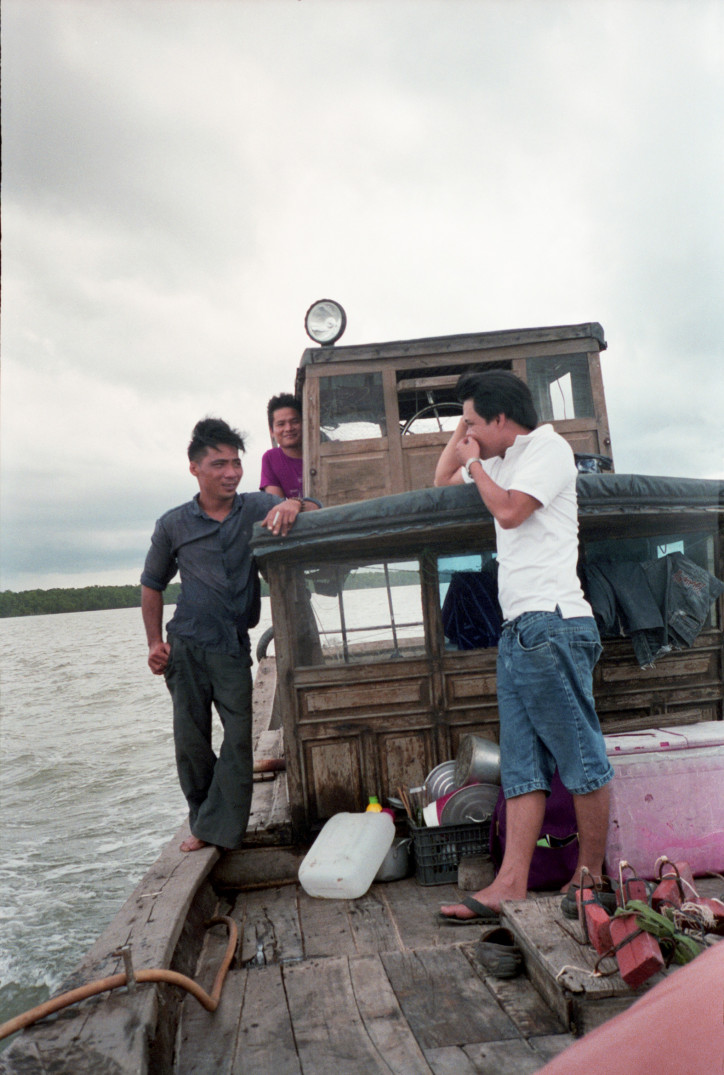
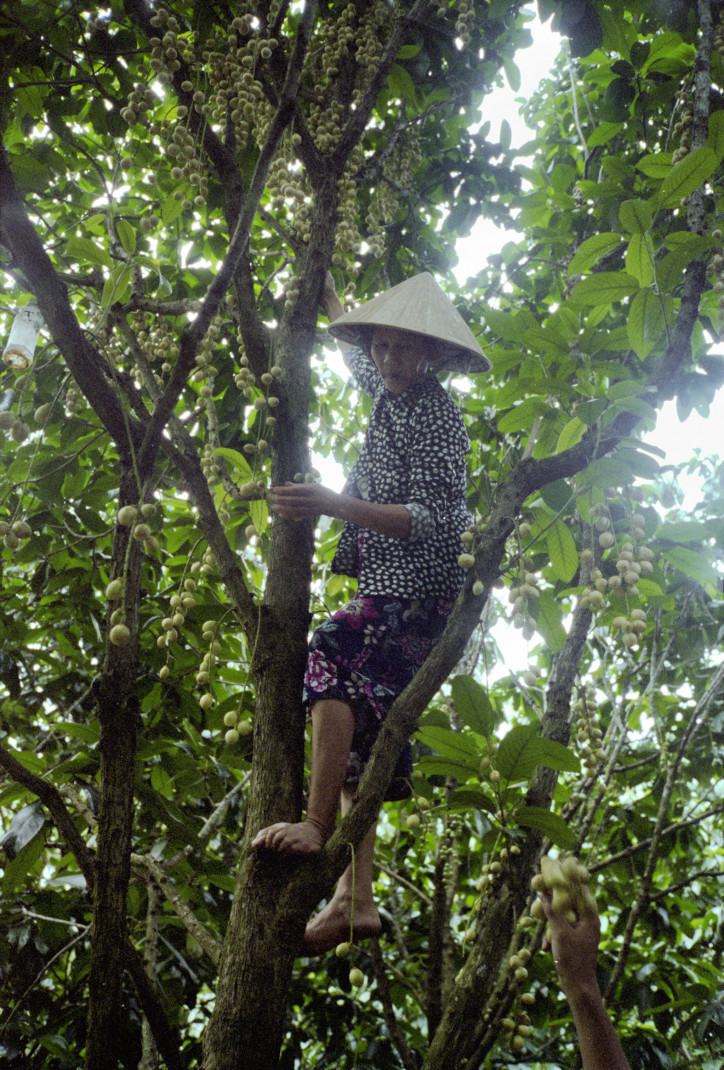
On each day, Woman Number Seven sells 80 portions of soup for 20,000 dongs each; that’s a little less than one dollar. People need to eat: the vendors working at the market as well as the tourists, coming here for short visits like swarms of insects. To her, foreigners and city kids mean good business. She used to run a restaurant in her family village, and when the demand went down, she moved to the water. The only problem is that she finds it difficult to navigate between all those large and fast tourist boats, so she needs to be very careful.
She’s been feeding the people of Cái Răng for several years now. She gets up at 1.30am, prepares her carrots, cabbages, tomatoes, meat, Thai basil, field bindweed, tapioca and rice noodles. And the two huge pots of water she boils on the boat, on coals that smoulder in stoves under the wooden table. That’s the worst bit of her job – to get the coals going, and then to feed the fire, lifting heavy cauldrons. The doctor says she shouldn’t carry weights or bend down.
She was 40 years old when she gave birth to her only son. He is an adult now, working in Cái Răng as the captain of a wholesale boat. Just like his father, who is enjoying a rare day off today and spending it with his wife on her boat. The man is sitting at the bow. He writes down the number of soups sold, adds coals to the fire, but mostly just smokes his cigarettes and chats with clients.
Wholesale boats go around all nearby canals and all the river arms. They buy produce from farmers and then sell it here, in Cái Răng. On every boat, there is a stick near the bow with a piece of fruit or vegetable stuck on it to inform what kind of goods there are for sale there. However, many smaller boats come to those large, pot-bellied ones. They join for a few moments with hooks on short ropes. Transactions are swift, and the goods are transferred efficiently; bags travel from one pair of hands to another, large fruit and vegetables – pumpkins, papayas, melons – are just thrown from boat to boat. But first, one must haggle. This is something best left to women. Anyone can see that here, in the Delta, women are the ones who breathe life into the local society and economy alike. They trade, count money, sail, ride motor scooters, manage. They work hard, but also watch over businesses and make decisions. It is women who say where to unload the goods, how to present them, and at what price to sell. It’s not a comfortable position to be in, but surely a strategically sensible one.
Trading times in Cái Răng are short – just several hours a day. By 8am, the traders can rest and eat some soup. For Woman Number Seven, the day is not even halfway through. Once she’s sold the last portion of her soup, she docks her boat, goes to the market, and prepares the second meal for the afternoon. At 5pm, she needs to be back on the water to feed the traders. They remain here until they sell all their cargo. Only then can they go back to travelling around the canals.
What she likes the most about her job is meeting people and talking to them. She finds it energizing; it gives her the motivation to carry on. The lonely hours of preparing the meals by herself are the saddest ones.
The further away from here, the better
In my conversation with Woman Number Seven, I am aided by 25-year-old Tea. He’s a college graduate, and having studied English he now works as a guide and interpreter. Tea is a freelancer, not yet sure what he wants to do in life. Except that now, he wants to live in Saigon. “This city is a dream come true,” he will say to me later, when we ride his motorbike along narrow paths and bridges, cutting through tiny villages scattered over the water. “In Saigon, nobody cares who I am. I can live any way I like.”
Tea is gay and needs some freedom. His parents keep asking when he is going to get himself a wife. Marriage is the most important family investment. In larger Vietnamese cities, people stay together in multi-generational homes. Children and grandchildren are a way of securing parents for old age. Tea says his mum is like Woman Number Seven. She works all the time, managing three shops: one with fruit, one with general groceries, and a bakery. She supports the family. It’s the second one she’s been looking after over the years, because she divorced Tea’s father when he was very young. The man is a mechanic, fixing motorbikes. Unlike his ex-wife, he has no ambition to better himself.
On the next day, we will catch a flat tyre. When we finally wobble down to the garage, Tea will say his father looks a lot like the man gluing up the tyre. We’ll sit on the plastic stools by the road. The mechanic will insert the tyre with a rubber patch into the metal jaws of his vice, and then he’ll sit with us and tell us the short story of his life. The son of a mechanic, he grew up among wrenches and the stains of machine grease. He works to support himself, his wife and three children. The wife, carrying the youngest daughter in her arms, will come out to say hello. The house looks like almost any other one in Vietnam: a shop of some kind in the front, and living space in the back: day room, kitchen and bedroom all in one, and a toilet outside or in the very back. Fixing motorbikes and motor scooters in a country where everyone rides them used to be a good business. However, even this is changing. “Motorbikes are getting more modern, they don’t break down so easily anymore,” the mechanic sighs. “And they have computer software installed now. I have to keep learning new things to keep up with the market.”
Neither time nor so-called progress are his allies. The road by which we are sitting will be widened to fit the trucks that transport produce to the cities. The local administration already informed them that they will be forced to move. They don’t know what compensation they will receive and when. Soon, the tyre is fixed. How much does it cost? About as much as a bowl of soup from Woman Number Seven.
Looking at the food vendor and the mechanic, Tea sees typical members of his parents’ generation – those who got the first taste of capitalism in post-war Vietnam. “They know nothing other than work. They don’t know how to stop working. I don’t want to live like this,” says the young man.
Before leaving the boat, I asked Woman Number Seven if she ever rests. She takes breaks when she feels very tired, and her doctor tells her to lie down. But it’s putting away the money she makes that gives her the most joy.
“See,” comments Tea with sadness, “it’s workaholism. A way to escape war and poverty. Incurable.”
From year to year, the market in Cái Răng is shrinking. Not long ago, over 100 boats would come here every day. Now, it’s half of that at best. More and more groceries and fish are transported on land, because this century saw the Delta’s rivers grow thick with bridges. The largest infrastructural junctions were built near Cần Thơ, a city of over one million. But driving on any of the main roads in the region means constant rolling up above rivers and canals. It’s a panorama of village homes, boats and barges, bridges, bustling markets, and poverty-ridden stilt-homes made of sheet metal. Until recently, those waters were the only tracts to connect the people who lived here, which is why most homes are facing the canals. Where there aren’t enough bridges yet, ferries carry the commuters back and forth. Some are tiny – they can fit just a few motorbikes, and all they sell during a minute-long journey is coconut water. Others are those monstrous beasts that carry across buses. As soon as they arrive, dozens of vendors rush in to offer anything you could think of, from eggs to lottery tickets. In many villages, there are still boats going back and forth from one side of the river to another. They transport people and goods. It is women who take the oars and hold the tiller.
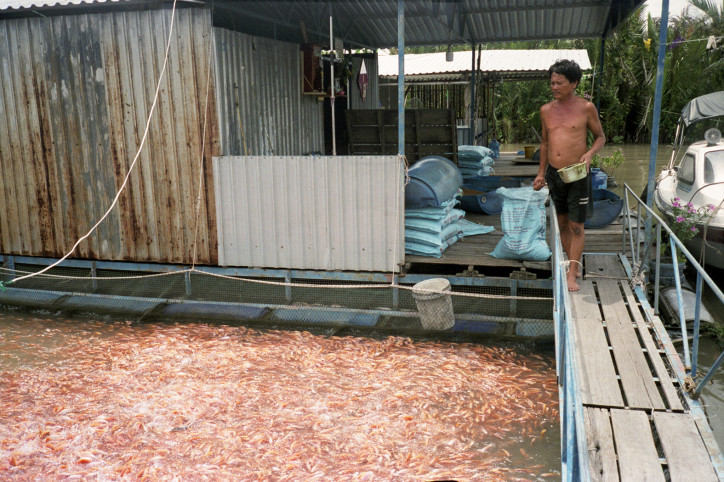
Tea is a typical representative of the new generation: he is looking for a way to escape forward. He wants to be where new opportunities await. He says Saigon is just a stop on his way; the real goal is to travel abroad. Tea comes from a little village near Hà Tiên, a fishing town in the westernmost part of the Delta, near the Gulf of Thailand. His family used to farm their land, growing various kinds of fruit there. But since the soil salinity began to increase, their chances of making a living have been shrinking. “They started farming pineapples because they are more resilient. Now, all they can grow is grass. The kind used for weaving mats. Nothing else will grow there,” explains Tea.
He has left his village forever. Not everyone manages to escape, though. On a Saturday afternoon, we visit his college friend. Truc is a filigree girl, measuring a little more than four foot nine. She has narrow shoulders, tiny hands, a mouth, eyes. She wears her hair pinned up in a bun. Seeing her delicate frame rushing from one client to another, I cannot help but think of Mrs Pepper Pot, an industrious cartoon lady who, despite her minute posture, is very powerful. Truc runs a small café in Nhơn Nghĩa, a rural part of Cần Thơ. She is helping her mother, who inherited this business from her own mother. Granny had a nose for business: she set up her café right where the ferries dock when they carry passengers to and from the main part of the city. And there is a school next door, too. Right now, a group of children wearing blue kimonos are practising a Vietnamese martial art in the schoolyard.
Truc serves the last coffees for today. She is closing at 4pm. The café opens before 4am, when the first ferries take off. She and her mum are up from 2am every day. Truc does everything here: she orders coffee, ice, milk and bottled drinks from the suppliers; she serves customers, cleans up, manages deliveries, counts stock. As long as her younger sister is in high school, Truc has to be here. She is not happy, though. She didn’t go to college for this. She also wants to be a guide. And to leave for northern Vietnam, to have a lot of children. “Do you like kids? I love them,” she giggles, watching the tiny warriors outside. So far, this scenario is not likely to happen. A customer rushes in, calling loudly for her ice tea; she’s running late for her ferry.
What will happen once a bridge is built around here? Then her dream will no longer be unfeasible. For Truc, it will become a necessity.
The king of one boat
When he arrived on his motor scooter, his disability was unnoticeable. What I saw was a rakish glint in his eye; his unbuttoned shirt revealing a naked torso. He took off his helmet, brushed off his long fringe, and send us a radiant smile. He waved his hand, wooden beads wrapped around his wrist: Follow me! At the gas station, he bought a 20-litre canister, put it between his legs and led us further out, to the canal where just one boat was bobbing on the water. It was his old wooden fishing boat. The man climbed the concrete bay so swiftly, and then jumped on board so nimbly that I didn’t notice his bad leg until later. It was twisted and much shorter than the other one. Sometimes, he would hold it when it refused to move; on other occasions, he leaned on it like on a crutch. On his boat, he was the king. He kicked off his flip-flops, threw his helmet on the floor, untangled the ropes, lifted rusty anchors and gave several curt commands to his helper who, distracted by my presence, just stood with his mouth open instead of pushing the boat away from the shore. And we were in a rush. It takes at least two hours to travel by boat down the Hàm Luông River to the southernmost end of the Delta, where this arm of the Mekong flows into the South China Sea. The return journey takes a bit longer. For the most part of the journey, we were pushed forward by the favourable wind. The boat sailed smoothly, and the captain did not have to exert himself. He lay in a hammock, holding the tiller with his healthy foot, smoking cigarettes and watching the horizon open up ahead of us. The closer it gets to the sea, the broader the river’s mouth stretches. Mangrove-covered riverbanks pull away, the water becomes saltier and clearer. I sat next to Si, a farmer from a village near Bến Tre, who helped me with this journey. We put our hands in the water and licked salty droplets from our fingers. Si laughed. “Tastes disgusting,” he commented, spitting.
Closer to the sea, our surroundings have changed visibly. Back near the Hung Phong island that split the river in half, we could still see fruit groves near the riverbanks. Rice fields would stretch in the distance, together with vast patches of beans and tomatoes. Soon, they were replaced by prawn farms. Shallow pools, lined with sheets of black plastic and long rows of turbines for water oxidation. In order to grow, prawns need a lot of oxygen, which makes farming them one of the most environmentally-harmful businesses, polluting the air with fumes and carbon dioxide. And it’s not like this business grows fortunes, either. The homes of local farmers look poor, and unlike most in the region, their roofs are still thatched, covered with palm leaves instead of roof tiles or sheet metal. Bent down to the ground by strong winds and monsoon storms, they look almost flat.
The whole Delta is drowning. The land is slipping down by two, three centimetres a year. One of the reasons is the monstrous amounts of freshwater being pumped out from the ground for crop irrigation and to fight back soil salinity. The farmers find their own ways of combating problems as soon as they arise. But usually, they don’t realize that by eliminating one problem they cause new ones. And even if they do know it, what else can they do? They’re just trying to survive.
Once we get out onto the sea, we can feel the swift, cool wind, and the Earth becomes round. The horizon bends in an arched line, the sky looks like a dome made of light clouds. From where we are, I can see several dozen fishing boats. Some are catching fish, others use special booms to search for crabs and shrimp. We don’t stay in the open sea for long. There is a great downpour coming down from the river. We can already see the steely curtains drawing upon the sky over there.
Now, the captain is no longer smiling. He rushes his helper, the boat turns back, we sail against the strong wind. Short, fast waves slap the bow. A quick hand wave: Go to the back. Just in time. I step down to the lower deck right before we enter the storm. The wind throws our captain’s helmet into the sea. He glances after it without regret; now he holds the till with both hands, spits his cigarette out into the water. Drawing my knees to my chest, I watch the blurry landscape disappear behind. The sea and the horizon have changed into a murky, dun-coloured fresco, the boats are little more than restless spots, rocking on the waves. When the rain stills a little, the helper will come down to the lower deck to prepare the rods and nets for the evening fishing. He rolls the fishing lines into neat bundles and examines the net, looking for holes in the mesh.
They go fishing every day, even though the results are getting worse. Si remembers that before he started a family and settled at the farm in a village near Bến Tre – where I’m staying for a few days – he used to regularly go with the captain to do some fishing. All you had to do was throw a line into the water and you had a beast of a catfish dangling off your hook. Today, catching a dozen kilograms of fish feels like a challenge.
We go back up the canal among farms. Low, long fishing boats glide past us. They are homes to whole families, each with a dog. At noon, some of them go to the side and get some rest among the palm trees. After a quick goodbye, the captain jumps on board once again, starts the engine and lights another cigarette. It’s time for a proper trip, this time to get some fish.
He is 30 years old. A real master at his job. He cannot do anything else, but it seems he will be forced to learn. Many of his mates already have. Si grows fruit together with his father and wife. They also started a bed and breakfast. In several plain rooms under a thatched roof, they host visitors like me. They feed their tenants with local food and with rural silence, sometimes interrupted at night by neighbours singing karaoke.
Life measured in metres
At the other side of the Delta, near the Cambodian border, ominous changes gain pace. Just this year, the water level in the arms of the Mekong near Châu Đốc dropped by two metres. The situation of local farmers has been difficult for many years already, but this change was a shock. They all know the reason. More dams were built up the river, in Cambodia, Laos and China. And for many years now, the Chinese have been refusing to cooperate with an international commission tasked with regulating the Mekong water problem. Keeping in line with its political strategy, Beijing refuses to participate in multilateral negotiations. The Chinese prefer two-sided dialogue, where it has a stronger position. They also keep pushing the strategy of facts, including new geological interventions, such as changing river routes or creating artificial islands that strengthen their military position. The poor economies of Laos or Cambodia view the dams (financed and managed by China) as their chance to make more money and energy. In a game where large economies are at stake, small farm orders are just a handful of tadpoles – all they can do is adapt to the changing currents. Near Châu Đốc, canals around rice fields are being deepened now, so freshwater gets a chance to reach the crops. Rice is planted and harvested three times a year here. After every harvest, stubble fields are burned out. The ashes serve as a natural fertilizer, but it’s becoming less important now. The crops can no longer survive without chemical boosters. There isn’t enough water or seasonal floods that would nourish the soil. During the rainy season, not enough water reaches the fields, because it’s being held away by the dams. And in the dry, hot season, when China’s demand for air conditioning spikes rapidly, water is thrown into the turbines with such force it drowns the regions down the river. Vietnamese farmers, being the last in this sequence of events, have no way of responding to the situation.
Here, in the Delta, everything is diminishing nowadays. Life is shrinking, narrowing down. Seasonal floods were beneficial in more ways than one. Rivers used to bring tons of fish onto the fields. All the families had to do was set up traps made of grass and leaves to catch to their hearts’ content, and then sell hundreds of kilograms of fresh fish every day. Nowadays, you’d be lucky to catch 30 or 40 kilograms.
Not long ago, back in 2003, fortunes grew everywhere around. Export sales of the famous Mekong catfish led to dozens of luxury homes popping up all over Châu Đốc. But soon, a lawsuit from their competitor in the US made the catfish suppliers increase their prices, and the whole scaffolding of profit went tumbling down. Many people went bankrupt. They still fish, but only on a small scale now.
On the other bank of the Bassac River (another arm of the Mekong), opposite the city centre, I visited a family that belong to the Muslim community of Cham people. These gentle followers of Islam live in harmony with local Buddhists – who are the religious society in the region – as well as with Khmers, Chinese, and Vietnamese Catholics. The house I entered is 111 years old. My host, the descendant of a line of imams taking care of the local mosque, welcomes me and spreads a handwoven loom mat. He invites me to sit down, and explains that since his grandmother had this house built, there was only one instance when something had to be repaired. The imam points at a small floorboard, lighter than the others. It was attacked by termites, he explains. Other than that, the whole construction made of red Pyinkado wood remains untouched. It protects the family from the rain, wind and heatwaves.
The family lives according to tradition. The men put on their sarongs and embroidered caps to attend prayers (women pray at home). However, in business, they chose innovation. The farm on the back of their house is getting overgrown; it made little sense to cultivate the fields any more. The family of nine makes a living out of selling used clothing. They run an online store and have a warehouse in Saigon, from where they deliver clothes to markets and individual shops. Second-hand clothes make for important business by the borders. Since the end of post-war hostilities in the 1990s, cross-border trade (selling tobacco, food or cattle) has largely replaced the farming and fishing that used to be the main source of income for the local people previously. Cheap clothes arrive from Thailand and Cambodia. At the markets several kilometres from the border, you can buy trousers or shirts for as little as one dollar. And it’s even cheaper when buying in bulk.
The imam’s pimply-faced nephew joins us. He won’t be selling anything. The boy is about to graduate from a university in Long Xuyên, a big city in the Delta. He will become a maths teacher, but still, he is going to marry the cousin chosen for him by the family. Even when the world is turning upside down, they manage to save at least this aspect of their identity. The Chams are not wealthy, but it seems more important to them to remain united within the community. Even their new homes, now built out of concrete, still resemble the century-old ones. The disappearing water will no longer pose a threat to them, and nobody keeps their cattle under the stairs anymore; still, the new houses stand on tall stilts, making the neighbourhood look consistent in style.
I go to one of those houses and enter the yard. The owners still run a weaving shop in there. On the stilt under the kitchen, I notice marks showing water levels during the annual August floods. The one in the year 2000 reached half a metre above my head. The one from last year would have barely lapped at my ankles.
Steel rain
Today, the Mekong Delta tells a story of the dire consequences of human interference with naturally-regulated elements. And of the daily survival strategies, too. Change no longer happens gradually, from one generation to another. Nobody can be certain of anything anymore. This fertile culminating point of a great river used to provide enough natural resources to help the local population grow by tenfold in just several decades, until it reached the current number of 20 million. However, the myth of the life-giving flood waters is drying up. A new magnet is glittering on the horizon: the city of Saigon is growing sky-high, becoming similar to Singapore, the model of a South-East-Asian success story. Tea and Truc are looking towards the bigger cities. It is also where the son of the last blacksmith in Cần Thơ went to work.
Man Number Six starts the fire in the forge. He is using coconut shells and a few handfuls of dry rice shells as kindling. His wife sits in an elevated spot and presses down on pistons in two vertical bellows. The air heats up the coals inside. The blacksmith inserts a piece of steel inside and crouches on a wooden platform. We wait for the material to heat up. I start asking questions.
He was 14 years old when he started to help his dad make tools. Today, he is 67 and still works. Never changed his technique. He makes his steel knives, scissors, saws, hammers and cleavers on the very same anvil his father used. Sure, not many people need his services any more. People prefer to buy mass-produced knives in the store. But those who understand quality keep coming back to him. Like the vendors from the local market. Those women clean, gut and prep hundreds of fish and vegetables every day. They cut up buffalo carcasses. The blacksmith says he has kept long-term business relationships with many of them because he makes the best-quality tools. “How long does it take to forge a knife like this one?” I want to know. “Two hours,” he says. “And how long does it last?” “Twelve years,” explains Man Number Six. “If it breaks, I’ll fix it. If it goes blunt, I’ll sharpen it. You know where I get the steel from? It comes from the sky. Look, there are no iron ore mines anywhere in this region. Back in the army, I was a sapper, I know how to dismantle unexploded shells. The Americans dropped more bombs on this region than the whole of Europe had thrown at it. I find them and turn the materials into something useful. Something to help life go on.”
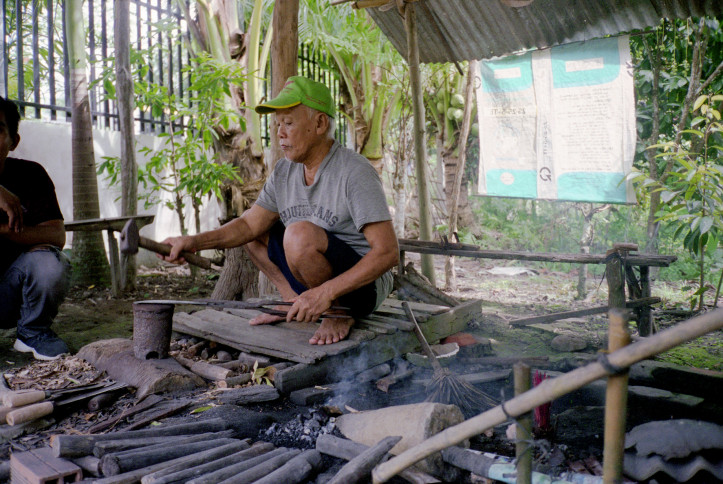
The blacksmith looks into my eyes. “Everyone can find a spot in the world and make it theirs,” he tells me. “My sons are bankers, they live in the city. I support their decisions, I’m not surprised at all. They can work in clean offices, not here.” He shows me his feet, blackened with ash, and palms calloused from years of hard work. “I am proud of what I have done with those two hands. I used my earnings to educate my children. I forged my work into their success.”
I walk around a quiet garden in the back of the blacksmith’s house. Suddenly, I hear a rustle behind my back. It’s the blacksmith’s wife, slim and youthful despite her age, deftly climbing a tree. All she needs to do is put her feet on the trunk and pull herself up with her arms. Not a single branch bends under her weight. Moments later, ripe fruits fall down on the ground and roll in my direction. I don’t know their name; I have never eaten anything like them. I pick one up, tear at the coarse skin. Juicy flesh sprays my fingers.
Two ferry trips and dozen-odd little bridges later, I will be sitting in a traffic jam of motorbikes congesting the centre of the modern Cần Thơ. A manager of a hip café that opened in a former colonial building will hand me an iced latte. Around me, people will be on their smartphones, fingers gliding across shiny surfaces. Here, everyone has already stepped across to the other side of the looking-glass.
Translated from the Polish by Aga Zano


